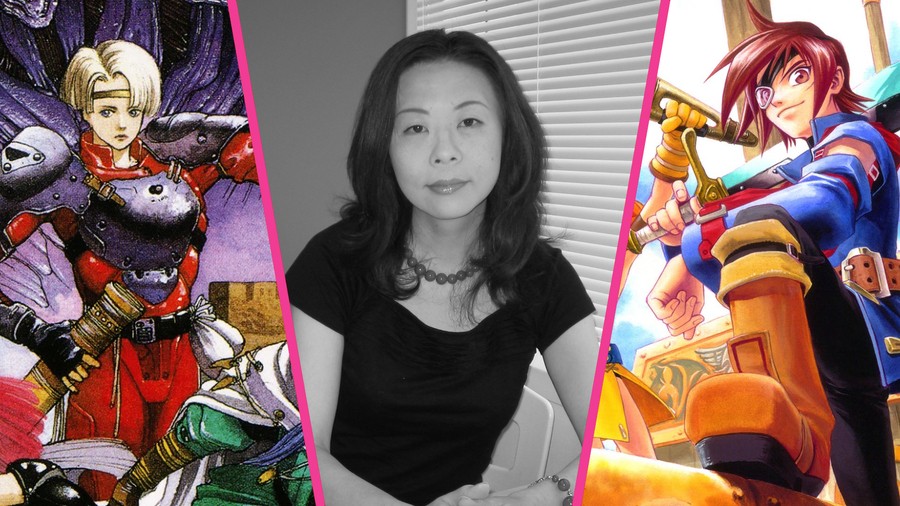
As part of our end-of-year celebrations, we're digging into the archives to pick out some of the best Time Extension content from the past year. You can check out our other republished content here. Enjoy!
In May of this year, Rieko Kodama sadly passed away at the age of 58. She was one of the first female game developers to gain worldwide recognition and was part of the core team which created Phantasy Star, one of Sega's most influential game series. She was also involved with titles like Sonic and Alex Kidd, and oversaw the creation of Skies of Arcadia and 7th Dragon, as well as the recent Sega Ages series.
Born in Kanagawa, Japan, she initially considered working in advertising in high school, but became interested in graphic design at college. In 1984 she joined Sega, starting with character design for arcade titles such as Champion Boxing and Ninja Princess. Kodama built up a reputation as an artist and was soon given a chance to work on larger projects, such as being the main graphic designer on Phantasy Star, and was responsible for creating all the character designs, the 2D maps, battle-scene backgrounds, and townspeople, among other things. Later on, she moved on to the roles of planner and producer.
What follows below is the combination of three different interviews with Rieko Kodama, undertaken for LEVEL magazine in Sweden and provided by Tobias Bjarneby – who, as well as being one of Sweden's most famous games journalists, is also the writer and director of 198X. It was first printed in The Untold History Of Japanese Game Developers and has been edited for clarity.
Tobias Bjarneby: Where did you find inspiration for Phantasy Star?
Rieko Kodama: With regards to the game design - the game system, 3D dungeons, graphics, and so on - we wanted to develop something that was different from console RPGs that were popular in Japan at the time. The team created the game with new elements such as the adoption of the 3D dungeons, animation of monsters, animated 2D field/town maps where, for example, the water's edge was moving, and illustration-like graphical cutscenes. We were not inspired or influenced by other works very much, Phantasy Star was born as we took on the challenge of creating something different from console RPGs that had been released before.
How did you and Yuji Naka work together on the game? What were your roles?
Naka-san and the person responsible for the scenario established the development team as they wanted to create an RPG within Sega; I joined them as a graphic designer for characters and maps.
I was in charge of graphic designs for characters, field/town maps, and so on. The features I thought up were the graphic design images in the entire game. Because it was so far removed from "fantasy", which was the representative style of RPGs we had in Japan at that time, I incorporated things that would give players a sense of familiarity, such as medieval European armour in the characters' costumes.
It's been said Yuji Naka and the team were quite influenced by Star Wars.
I guess the title was certainly influenced by Star Wars in terms of how the story is set in outer space and the way human-type and non-human-type races take an active role in making friendships. While we loved Star Wars, and we wanted to convey such visual power and story in the form of a console RPG, the movie did not influence us to begin the development of Phantasy Star.
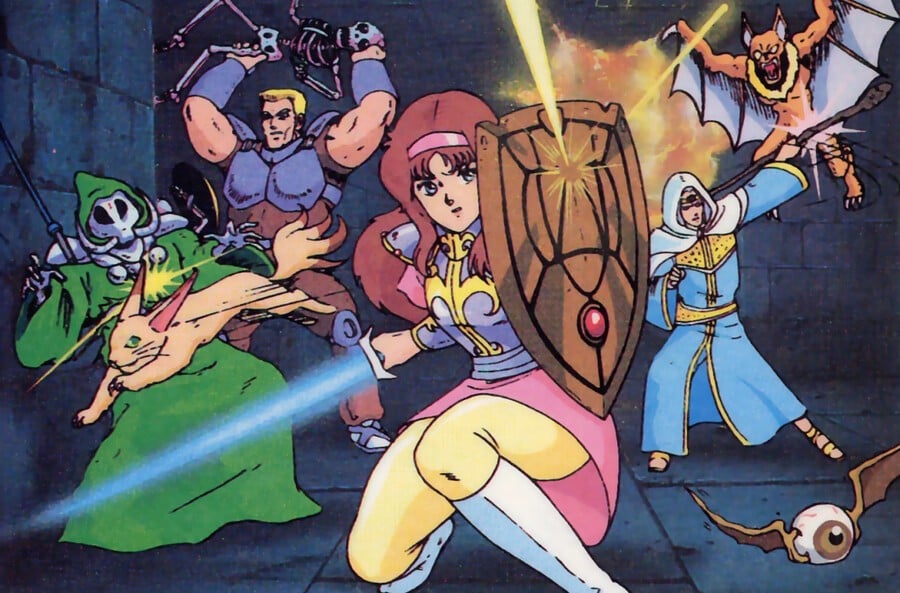
When designing the characters for the Phantasy Star games, how much of your own personality did you bring into it? Can you find something of yourself in Alis?
I don't know if any of my characteristics were reflected in Alis, but I would like to be the kind of person who adheres to my own will, and does not let my troubles get me down, much like Alis strives in the game. As for the other characters, there are people in the development team who they could be like. I think we could make friends with them, fight together believing in each other, and make a journey together.
Regarding character personalities, how did you create Alis? What kind of character did you want her to be? And what kind of feelings did you want to express?
I designed her as I expected her to be a character that many women, including myself, could empathise with. She is a woman that other women would feel like supporting and making friends with.
Where did the other characters' personalities come from? What were your inspirations for Odin and Noah?
As two men Alis can depend on, I designed Noah with intelligence as his best feature, and Odin, with power as his. I tried to create Noah as a mysterious character, while portraying Odin in the image of a typical leading man in heroic fantasies. Though their personalities are different, I imagined the contrast of their visual designs to be like Raistlin Majere and Caramon Majere in Dragonlance, a series of novels from Advanced Dungeons & Dragons. Noah is far more gentle and a better person than Raistlin, but may be similar in the fact that they are both low in physical strength despite their powerful magic.
What do you remember from the development of the game? Do you have any favourite memories?
At the time we had none of the CG tools we have today, but even so we made the 3D dungeons. Frame by frame we had staff create the animation stills, and then we manually put them together to create motion. I was touched when I saw the dungeons moving smoothly on the screen. They could be created with CG software easily now, but it was a continuing process of trial and error back then.
What are your favourite parts? Do any characters or storylines have a special place in your heart?
One point is that this is a game with a female leading character. With this, we could challenge the stereotype that the main characters of games should be men. It would be fairly difficult for male users to empathise with a heroine, but I was happy we could try something new. Another point is that we could attempt various things like animated maps, or one with moving walkways, 3D dungeons, animated enemies, and so on. Also, I feel glad we achieved things that had not been done in console RPGs before that, like displaying the characters' expressions with large images.
What are your personal feelings for those early Phantasy Star games?
To me, these were RPGs I developed for the first time, and I suppose it overturned the view of console RPGs that Japanese people had at the time.
Would you say games are firstly pure entertainment, or do you think it's more important games can be special places players can escape to?
I do not think it is bad to enjoy games because people want to get away from routine; I myself sometimes get lost in reading books, games, or movies, as I want to forget everyday life. However, I believe games should not be created as a place to run away to, and there should be no game developer who makes games with an intention like that. I would like players to enjoy a game, however, as they are absorbed in the lore and stories we offer.
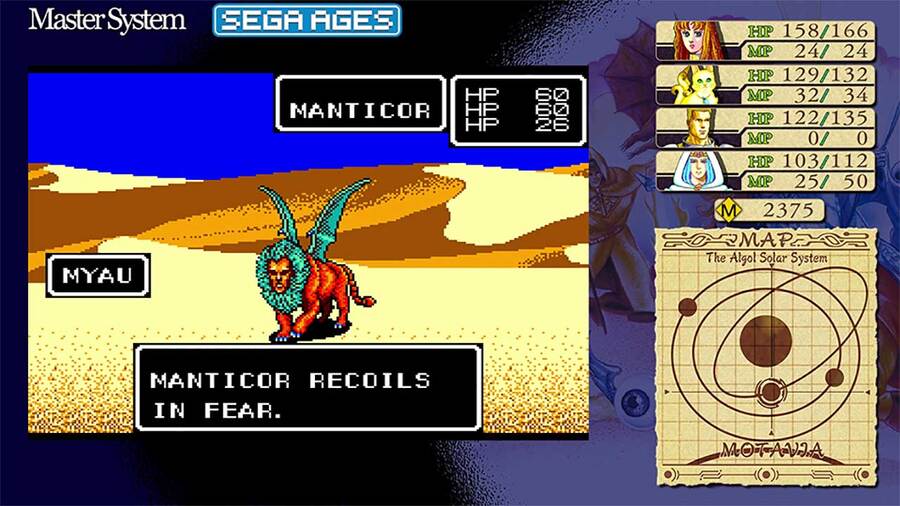
People can communicate with each other through games. For example, you can talk with those who enjoyed the same game after playing it, or exchange information. In that regard, you can say all games are entertainment. I want a game not to be just a place to escape into, but something that is to be enjoyed both during and after the playing of it. Like books and movies whose emotions are shared all over the world.
Phantasy Star IV was planned for Mega CD. How did it affect development when you switched to the Mega Drive? Would it have been a different game on Mega CD?
At first, we had the option of choosing Mega CD. I remember we decided to release Phantasy Star IV on Mega Drive at a relatively early stage. If we had developed it on Mega CD, I guess we would have added many cutscenes. It would have taken advantage of the high capacity of CDs, such as for the music and featuring vocals. However, though it was called "CD", the base of its hardware was the Mega Drive, and if asked if there were great differences between those two systems, I would say there was little difference.
Old magazine previews show you initially planned to implement a 3D perspective for the dungeons, like the one in Phantasy Star on Master System. Was that idea abandoned because of the shift from CD to cartridge?
We did experiments. The reason we abandoned the idea was because the rendering capability of the Mega Drive was insufficient to express the more realistic, natural caves we were thinking of at the time for 3D dungeons. Even if we could have increased the number of dungeons and if we had adopted CD instead of cartridge, the limited drawing capability would have kept the graphics simple, and they would look unspectacular
The Macro system for the battles was a big step forward from the previous games. Can you please tell us about the system?
I do not remember well now, but the system was prepared so that the player could pull off combinations of attacks they had found more effective, and that the user who had found their own combinations could set them in advance to use at any time. This system was created with the main focus being on personalised customisation, rather than to simplify the input system in battles.
How did you come up with the Hunter's Guild?
The Hunter's Guild system was created since we did not just want the game to progress only with the provided scenario; we wanted an element that would allow the user to play stories by selecting them on their own. Also, as the hero's class was "Hunter", we wanted it to be helpful in drawing attention to the character's personality, and letting the player have a sense of working and living within the in-game world.
The Phantasy Star games don't shy away from killing off major characters. At the time, letting playable characters die was unusual. Were you worried players would be upset?
We were greatly concerned, but we adopted the story, feeling it would allow us to express how the hero matured by overcoming the death of his mentor. This certainly offers a dramatic development as a scenario, but unlike characters we only read about and see in novels and movies, you actually get to play as those characters in games, and have a stronger attachment to them.
The character design for Dark Force is one of the elements that you have kept over the years. What inspired you when you first created it?
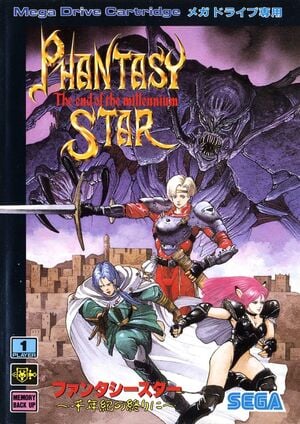
I guess Dark Force is people's malice that has gathered and consolidated. Not that a single person, devil, or monster can threaten the hero and his companions, but a little malice everybody has at the back of their mind accumulates and attempts retaliation toward people. The underlying setting is that people notice mistakes they have made after Dark Force appears, and correct them. I drew its design as I thought it could be an object that would give evil thoughts to people if it took visible form. However, since it is thoughts and feelings that gathered, its figure could vary depending on the people who see it.
The Japanese versions of Phantasy Star are a bit different from the English. Is this due to translation errors or did you intentionally change names and scenarios?
These were intentional. We consulted with the translators and the overseas staff of Sega at the time, and changed the character names and phrases into terms that could be easily understood by foreign players.
Many consider Phantasy Star IV one of the best RPGs ever made. In your opinion, is it the best in the series?
Since Phantasy Star IV was the first title where I coordinated everything from the standpoint as a director, I naturally have an attachment to it. If I speak just from the viewpoint as a creator, Phantasy Star I should be the best title after all. Phantasy Star IV is organised better with its game content and as a product, but we attempted more ambitious ideas in Phantasy Star I, things which had not been done before in console RPGs at the time.
You have said that Final Fantasy IV is one of your favourite RPGs. What is it that you like about that game? Do you have any other favourites?
I have played most Final Fantasy series titles. My favourites are III, IV, and VI. I remember I was immersed in all those games. I love their scenarios, characters, systems, worldviews, and so on, rather than finding particular points to be wonderful.
Skies of Arcadia started as an RPG for Sega Saturn. What were your ideas for the game back then? Did they differ from the way Skies of Arcadia turned out?
We had a big goal to create a "completely 3D RPG" with polygons, which was a cutting-edge technology back then. However, the conceived content was way too large to be processed on the Sega Saturn, so the project was carried over to the next generation of hardware, the Dreamcast. Even so, our initial concept of a "fully 3D RPG" never changed, regardless of the hardware change.
What were your goals with the story of the game? What feeling did you want to create for those playing?
Treasure Island, Moby Dick, Robinson Crusoe, Sinbad... In every country, the stories surrounding sailors and ocean voyages have always captured the hearts of children and even those of grown-ups, keeping them fascinated and inspired. We wanted to provide the same kind of experience once again through Skies of Arcadia's story and gameplay.
Moreover, people were not only exploring the world back then. While the mighty soldiers from Spain and England were waging wars, the merchants and scientists were making forays overseas in this era. Through the story, we wanted our audience to feel the atmosphere of an era undergoing significant change, when all kinds of people were excited and active. Then we moved the story setting from "the ocean" to "the sky" to allow the player to discover another enjoyable adventure on a bigger scale.
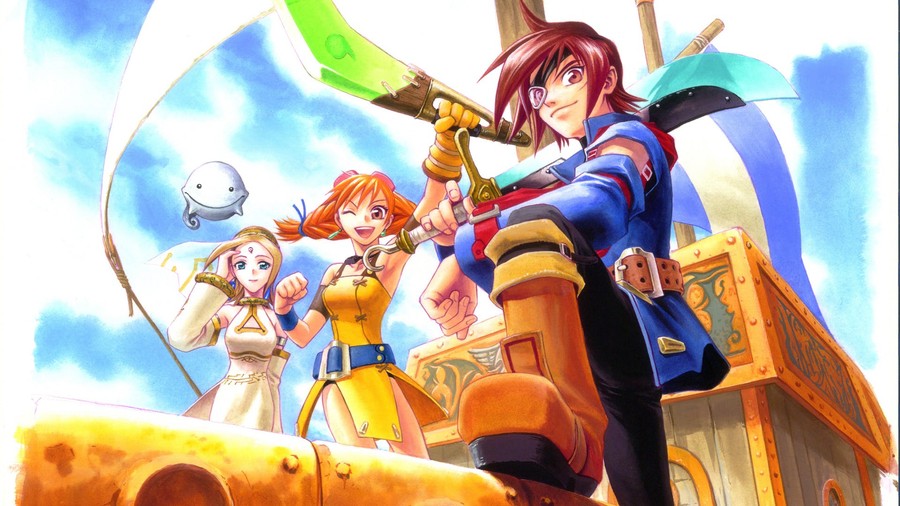
How did you come up with the idea to set the game in a world of islands in the sky?
The idea developed as we were pondering the most effective method to present our concept of the "fully 3D world". Normally you would express a piece of land in 2D, but as soon as it is adapted into 3D you can float it like an island in the air, and you can view the world on a wider scale: "viewing the ground under your feet and over your head". Alternatively, you can also utilise this 3D realm for a game of searching, by "going beneath the soil". It's a world on a large scale with plenty of reasons to explore... Creating such an environment would lead to an entertaining adventure RPG, so that's why islands in the air were chosen to be the setting of the game.
You made memorable characters in the Phantasy Star games, and Skies of Arcadia also has very strong characters. Vyse and Aika are perhaps the best examples. Please tell us how these characters were conceived.
Vyse, is characterised by his strong will to "never give up". The sailors in the past travelled across the water on vessels to reach the world beyond the ocean, often not even listed on a map. Vyse is a character who inherited all of the many aspects of the uncrushable spirit of these sailors. He is more popular among male players than female players. Although he is still a young boy, he has a qualifying attitude. He is popular for his manliness that makes you think, "I want go with him!"
As for Aika, we paid much attention to depicting her as "Vyse's good partner" instead of a girl. She is cheerful, energetic, and skilled. And under any conditions, even when she is separated from Vyse, she always believes in him. Anyone would be happy to have a friend like her around.
Since you worked so much with the Phantasy Star games, did you use them for inspiration, or did you try to stay away from them? Do Skies of Arcadia and Phantasy Star have anything in common?
Of course we applied the RPG creation know-how we earned through the Phantasy Star series, but we did not link those two together at all, because we were planning to create a completely new RPG which was separate from Phantasy Star. If I were to mention a common factor, that would be the fact various different species appear in Phantasy Star, as well as various people with different nationalities appearing in Skies of Arcadia. For both RPGs, we presented the differences between the residents and cultures of the game world with care, instead of just creating a vast world haphazardly.
There have been a lot of strong female characters in your games, and Skies of Arcadia is no exception. Did you consciously try to get strong female characters in?
I believe that a story or world cannot revolve around male power alone, you can not neglect the great amount of female power beside it. Therefore I did not consciously introduce a strong female character, it was rather coincidental. Moreover, I want people to find that the game is not projecting that a strong female is represented by a person like Aika alone, who is always tough in the battlefield. There is another type like Vyse's mother, who has a strong heart to hold back her own emotions at her child's departure.
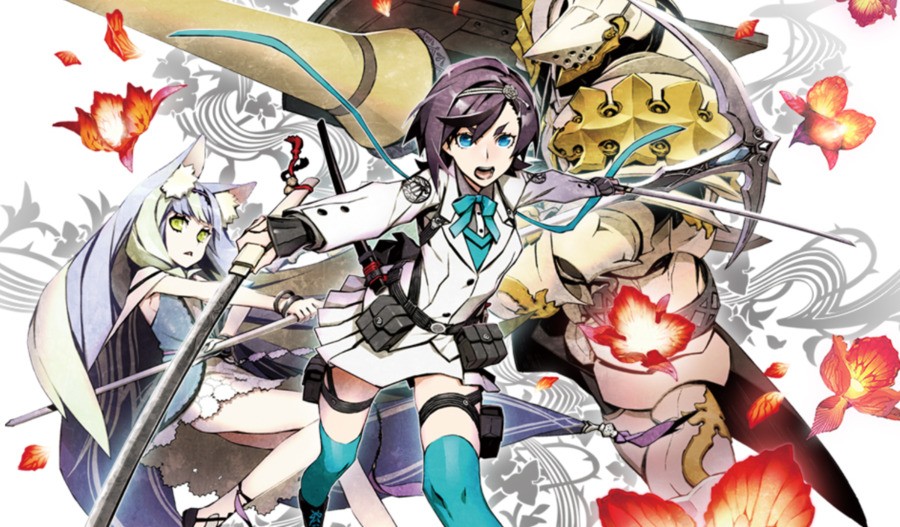
As a person with a background in graphical design, what was it like to make an RPG in 3D? Did you feel you could finally do things you had not been able to before?
All of a sudden the freedom of expression had expanded. I felt as if I was thrown into the ocean while I was swimming in a pool. In the beginning, I was lost, wondering: "how far can I swim?" and "how deep is it down there?" However in the end, I realised that as long as you "know how to swim", you can swim no matter where it is, in a pool or the ocean, and I started to feel more and more confident. The team also became more devoted to experimenting to achieve a higher quality. In that sense, both my team and I could survive in this ocean of the unknown "3D RPG".
Many modern RPGs tend to have extravagant CG movies to move the plot. In the case of Skies of Arcadia, the cutscenes are more simplistic, and the focus is only on the plot itself and the relationship between the characters. This makes the game feel more down-to-earth, like it could actually happen. Was this a conscious decision; did this force you to focus on the relationship between characters?
Although it is so common nowadays, back then we wanted to make a game based on the world of a "giant sandbox" wherein the character could walk freely and fly around. Instead of using movie clips, to progress the game, we chose a style which let characters walk around and experience the world. And because of that, I believe that the player could be left feeling like the encounter with the character really took place "on the street".
During the Dreamcast era, Sega published a lot of really inventive, original games, such as Shenmue, Jet Set Radio, Phantasy Star Online, and Skies of Arcadia. Did you feel that it was a special, creative atmosphere at the company during this time which enabled you to make all these incredible games?
Sega back then divided teams per studio to develop games. And I find that each title is characterised by the personality of the studio leader and the team very well. I believe that each studio developed its own uniqueness and methods while they felt "we want to be better than the other studios", which resulted in great numbers of unique titles full of originality being released.
What is your best personal memory from the production of Skies of Arcadia?
We had this stormy discussion over the visual character design of Vyse, which caused the team to split into two. Just to make decisions over the hair style, or trouser colour (white versus black); the heated discussion took place and continued until the morning, even involving the president of the company at that time!
I regard this as proof of the fact that everyone really cared for and loved this title to the level that they did not even want to compromise over the clothing styles - but as I recall it now, I realise that we did not have to get quite so heated. <laughs>
Looking back at Skies of Arcadia today, how do you feel? Is there something that you are particularly proud of?
I am very happy with it, especially as I realise this title is still cherished by people from all over the world even though it is about to hit its 20th anniversary since release. Moreover, I am still proud of the team who dedicated themselves and their creativity at their best for this title, without losing their heart, regardless of the exhaustingly long development period. This experience has been my dearest treasure, even now, as I was able to work with a fantastic team of people who are no less than the crew on the Delphinus.
Please note that some external links on this page are affiliate links, which means if you click them and make a purchase we may receive a small percentage of the sale. Please read our FTC Disclosure for more information.






Comments 2
Great consolidation of interviews. I don't recall coming across her name before, but after reading this, I see that she definitely had a large role in games I enjoyed very much and also she played a big role in a time when I loved Sega the most. I'm not a big RPG fan, but I love Phantasy Star 4 and consider it my favorite game of that genre. One of the things I always liked about Phantasy Star is how the games had strong female characters. I learned that such characters could be believable and even help make a story more interesting. Until then, I probably had a bias against that. When I got to Phantasy Star 4, Alys was my favorite character. Sad to hear Ms. Kodama died, and too soon. I am grateful for her contributions to gaming.
RIP Phoenix Rie - Legendary developer and massive contributor to early gaming.
Leave A Comment
Hold on there, you need to login to post a comment...